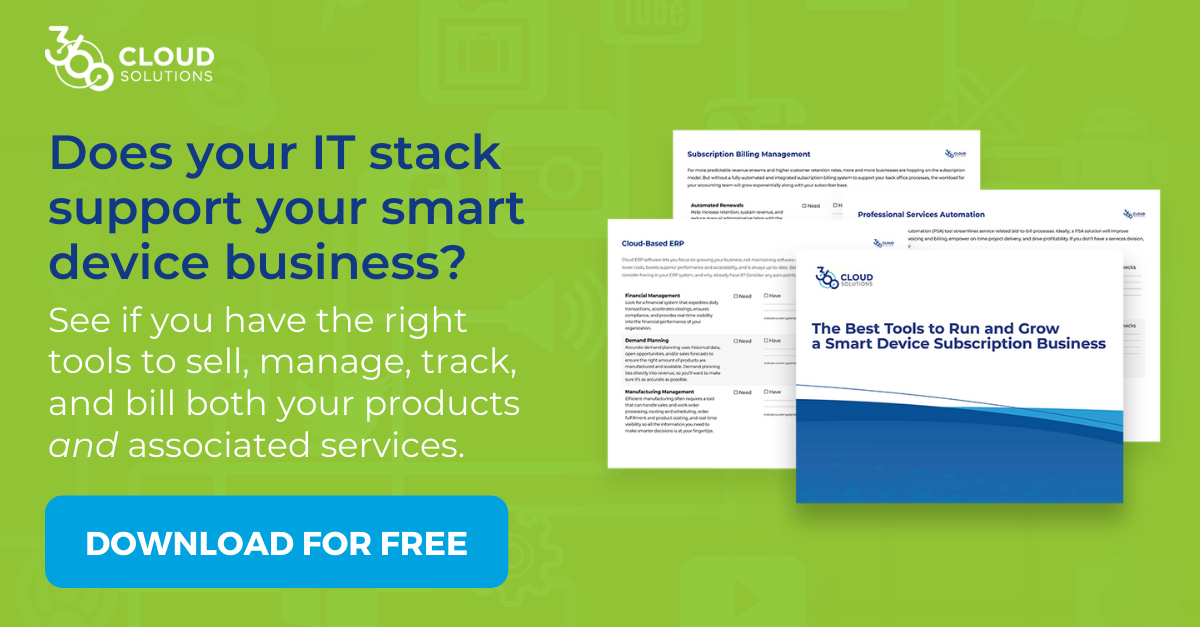If you’ve done any kind of shopping in the past few years, for business or pleasure, there’s no doubt you’ve come across the option to sign up for a subscription. It seems that everything from razors to food delivery services to software (and much more) comes with a subscription. Let’s take a look at what subscription billing is, why it’s so popular, subscription types, and drawbacks of the business model.
What is Subscription Billing?
Simply put, subscription billing is when you charge your customers a predetermined rate at a regular, predetermined interval, i.e. monthly, quarterly, or yearly. Subscription billing allows a business to spread charges over a period of time instead of all upfront—making your offerings more affordable and more attractive to a wider potential customer base. This also provides a stream of future recurring revenue that allows for business growth. Win-win.
Subscription billing models are well suited for businesses that offer physical goods, content, or services. Aside from the popular subscription box craze, subscriptions can also power software, streaming media, professional services, IoT-driven services (i.e. monitoring, metering), and more to businesses and consumers alike, and can be very profitable if set up and managed correctly. Many businesses are eager to shift from unpredictable, one-time transactions to a recurring revenue model where they can earn, recognize, and project revenue on a more reliable and consistent basis.
The Rise of Subscription Billing
While subscriptions are not a new concept, they have exploded in popularity—growing by more than 100 percent a year over the past five years. Why? The answer is pretty simple.
As Inc. explains, businesses make a lot more money charging monthly rather than receiving an upfront lump sum. Case in point: By switching from boxed versions of their software to Creative Cloud, a subscription-based suite of apps, Adobe’s stock increased nearly six-fold in five years and subscriptions account for 86% of Adobe’s total sales (Source: Fortune).
But subscription models alone aren’t inherently better than traditional ones; it’s the effect on the business and customer satisfaction that makes them so successful. Think about software. In Adobe’s case, they were relying on customers to upgrade existing programs when a new version was released, resulting in temporary and unpredictable revenue spikes. The recurring revenue gained when making the switch to a subscription model has been a big boost to the business. It has also allowed Adobe to focus on implementing the latest and greatest updates as they are developed rather than holding until the next major release when they very well may be already outdated. This not only keeps the product current but helps companies stay ahead of trends and able to meet customer demands, therefore increasing retention.
Popular Types of Models
If you are considering implementing a subscription billing model at your company, there are several routes you can take depending on your unique business and goals.
Fixed Fee
Fixed fee subscriptions offer products or services for a set price over the duration of the contract. By providing fixed fee subscriptions, companies benefit from high visibility into recurring revenue. Some popular examples of fixed fee subscriptions are monthly boxes (FabFitFun or Dollar Shave Club), home services (pest control or cleaning services), and fitness club memberships.
Hybrid
A hybrid model allows customers to add one-time purchases to an invoice without making permanent changes to their subscription. This model provides customers with added flexibility and control and sellers the opportunity to increase revenue by upselling and cross-selling products. A good example of a hybrid model is when a customer purchases hardware but pays a subscription for the software to run and update it or add additional functionality i.e. home security systems.
Usage-Based
Usage-based subscriptions allow customers to pay for only what they use. This type of model offers a high level of transparency to the customer and allows the business to adjust tiers as needed to satisfy demand. Some examples of usage-based subscriptions are cloud-based storage platforms, cell phone plans, and municipal utilities.
User-Based
In the same vein as usage-based, user-based subscriptions allow customers to pay by the number of users. Most often found in SaaS subscriptions, user-based plans also allow for a high level of transparency and predictable costs to the customer.
Subscription Model Challenges
While the benefits of subscription billing outweigh most drawbacks, most of the complexities revolve around the efficient management of recurring contracts. Without using a dedicated subscription billing management tool, many companies rely on spreadsheets and manual processes to keep track of bill amount, frequency, and duration. For very small companies this may not pose a problem, but as a business grows it can introduce many issues and challenges.
Properly Recognizing Revenue
When dealing with a multi-element subscription, i.e. software, hardware, and professional services, it can be difficult to correctly allocate the contract value in accordance with ASC 606 and other modern revenue recognition standards. Additionally, keeping subscription billing schedules separate from subscription revenue schedules with your financial management software can be a time-consuming and manual process.
Handling Contract Adjustments
If your business offers products or services on set terms—one price, for a set duration, at the same frequency for each customer—adjustments might not be an issue. But if you decide to offer promotions, upsells, or downsells, you need an efficient process to handle these temporary adjustments without altering the underlying terms of the contract.
Managing Multiple Contracts
Accounts with multiple active subscriptions can be challenging and burdensome to both the business and the consumer. For the business, it introduces additional administrative work to keep billing details accurate, especially when proration and co-terming are involved. It also introduces confusion when one contract ends before the other. On the customer side, it can be overwhelming and confusing to receive individual bills for each item rather than having them consolidated on one bill.
Scaling with Growth
With subscriptions increasing in popularity by the year, it’s important to have a future-focused mindset when it comes to your billing strategy. Just because your process can handle your current subscription billing needs today, will it be able to keep up with the demand in the years to come? Businesses should not ignore the hidden back-end cost of scaling subscription business models unless they have plans to automate them.
Customer Service & Retention
It’s important to remember that if offering subscription billing, your business needs to dedicate time to customer service and retention efforts. As a business that deals with recurring revenue ourselves, we know it is important to always provide clients with value. The minute they stop seeing value from your product or service, they will end the contract—and subscriptions can make that easy to do.
Managing Subscription Billing
The bottom line is that implementing a subscription billing model is a great way to build a predictable and recurring revenue stream and offer value and convenience to your customers. When billing is well managed using appropriate recurring revenue software and customer retention is high, your business will reap the benefits.
Supercharge your recurring revenue management with 360 Subscription Billing, a Built for NetSuite Native SuiteApp that automates recurring and subscription billing processes—end-to-end—right within NetSuite.



